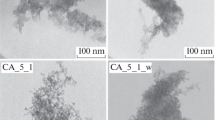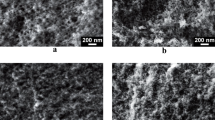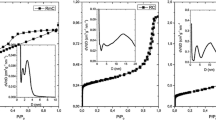Abstract
The aqueous polycondensation of resorcinol with formaldehyde proceeds through a sol-gel transition and results in the formation of highly crosslinked, transparent gels. If the solvent is simply evaporated from the pores of these gels, large capillary forces are exerted and a collapsed structure known as a xerogel is formed. In order to preserve the gel skeleton and minimize shrinkage, the aforementioned solvent or its substitute must be removed under supercritical conditions. The microporous material that results from this operation is known as an aerogel. p]Because resorcinol-formaldehyde aerogels and xerogels consist of a highly crosslinked aromatic polymer, they can be pyrolyzed in an inert atmosphere to form vitreous carbon monoliths. The resultant porous materials are black in color and no longer transparent, yet they retain the ultrafine cell size (< 50 nm), high surface area (600-800 m2 /g), and the interconnected particle morphology of their organic precursors. The thermal, acoustic, mechanical, and electrical properties of carbon aerogels/xerogels primarily depend upon polymerization conditions and pyrolysis temperature. In this paper, the chemistry-structure-property relationships of these unique materials will be discussed in detail.
Similar content being viewed by others
References
S.T. Benton and C.R. Schmitt, Carbon, 10, 185 (1972).
R.W. Pekala and R.W. Hopper, J. Mat. Sci., 22, 1840 (1987).
A.P. Sylwester, J.H. Aubert, P.B. Rand, C. Arnold.Jr., and R.L. Clough, Am. Chem. Soc. PMSE Preprint, 57, 113 (1987).
H.C. Geer, in Encyclopedia of Polymer Science and Technology, edited by H.F. Mark, N.G. Gaylord, and N.M. Bikales (Interscience, New York, 1970), p. 102.
L.L. Hench and J.K. West, Chem. Rev., 90, 33 (1990).
D.R. Ulrich, Chem. & Eng. News, 6(1), 28 (1990).
S.J. Teichner, G.A. Nicolaon, M.A. Vicarini, G.E.E. Gardes, Adv. Coll. Interf. Sci., 5, 245 (1976).
C.J. Brinker and G.W. Scherer, Sol-Gel Science, (Academic Press, New York, 1990).
J. Fricke, Sci. Am., 258(5), 92 (1988).
Aerogels, edited by J. Fricke, (Springer-Verlag, New York, 1986).
L.W. Hrubesh, T.M. Tillotson, and J.F. Poco, in Better Ceramics Through Chemistry IV, edited by C.J. Brinker, D.E. Clark, D.R. Ulrich, and B.J. Zelinski, (Mat. Res. Soc. Proc. 180, Pittsburgh, PA, 1990), pp. 315–319.
R.W. Pekala, J. Mat. Sci., 24, 3221 (1989).
R.W. Pekala and F.M. Kong, Polym. Prpts., 30(1), 221 (1989).
C.T. Alviso and R.W. Pekala, Polym. Prpts., 32(3), 242 (1991).
R.W. Pekala and C.T. Alviso, in Better Ceramics Through Chemistry IV, edited by C.J. Brinker, D.E. Clark, D.R. Ulrich, and B.J. Zelinski, (Mat. Res. Soc. Proc. 180, Pittsburgh, PA, 1990), pp. 791–795.
R.W. Pekala, C.T. Alviso, and J.D. LeMay, J. Non-Cryst. Solids, 125,67 (1990).
S.S. Hulsey, C.T. Alviso, F.M. Kong, and R.W. Pekala, in this MRS proceedings.
X. Lu, M.C. Arduini-Schuster, J. Kuhn, O. Nilsson, J. Frickes, and R.W. Pekala, Science, 255, 971 (1992).
S.L. diVittorio, M.S. Dresselhaus, M. Endo, J-P. Issi, L. Piraux, and V. Bayot, J. Mat. Res., 6(4), 778 (1991).
J.D. LeMay, R.W. Hopper, L.W. Hrubesh, and R.W. Pekala, MRS Bulletin, 15(12), 19 (1990).
R.W. Pekala and F.M. Kong, J. de Physique Coll. Suppl., 50(4), C4–33 (1989).
K.D. Keefer and D.W. Schaefer, Phys. Rev. Lett., 56(20), 2199 (1986).
D.W. Schaefer, J.P. Wilcoxon, K.D. Keefer, B.C. Bunker, R.K. Pearson, I.M. Thomas, and D.E. Miller, in Physics and Chemistry of Porous Media II, edited by J.R. Banavar, J. Koplik, and K.W. Winkler, (AIP Conf. Proc. 154, New York, 1986), pp. 63–80.
G.M. Jenkins and K. Kawamura, Polymeric Carbons - Carbon Fibre, Glass and Char, (Cambridge Univ. Press, New York, 1976) p. 84.
L.J. Gibson and M.F. Ashby, Proc. Royal Soc. Long., 382(A), 43 (1982).
J. Gross, J. Fricke, R.W. Pekala, and L.W. Hrubesh, Phys. Rev. B, in press.
A.W. P. Fung and M.S. Dresselhaus (private communication).
D.S. Knight and W.B. White, J. Mat. Res., 4, 385 (1989).
Acknowledgement
This work was performed under the auspices of the U.S. Department of Energy by Lawrence Livermore National Laboratory under contract #W-7405-ENG-48. The author would like to thank the following individuals for their technical contributions to this research project: Dr. James LeMay (mechanical properties), Suzy Hulsey (gas adsorption analyses), Dr. Dale Schaefer at SNLA (small angle x-ray scattering), Professor Jochen Fricke and Xianping Lu at the University of Wurzburg (thermal conductivity), and Professor Mildred Dresselhaus and Alex Fung at MIT (Raman spectra; low temperature resistivity).
Author information
Authors and Affiliations
Rights and permissions
About this article
Cite this article
Pekala, R.W., Alviso, C.T. Carbon Aerogels and Xerogels. MRS Online Proceedings Library 270, 3–14 (1992). https://doi.org/10.1557/PROC-270-3
Published:
Issue Date:
DOI: https://doi.org/10.1557/PROC-270-3




